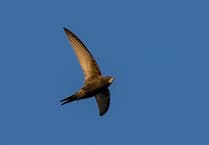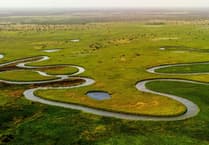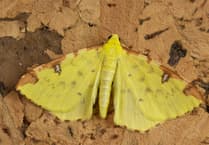Solar farms that are managed to support nature with long grass, wildflowers and hedgerows support more wildlife than surrounding farmland, providing havens for endangered farmland birds, butterflies, pollinators and other insects, and even mammals like hares, as recorded in surveys conducted by UK universities.
The initial installation work involves disturbance from groundworks, as well as soil compaction from machinery, both detrimental to wildlife in the short term. Access tracks, mounting frames and substations take up 2% of the area. However, the space under and between the rows of panels creates a varied habitat of sunny areas alongside shaded cooler areas with minimal disturbance over the 40-year lifetime of a solar farm.
A 2022 experiment at Keele University installed 12,500 solar panels, two wind turbines and a large battery energy storage system, and found that the land quickly recovered after installation, naturally establishing a native grassland habitat that was richer in biodiversity than the ploughed field which existed before. They concluded that solar farms can provide vital islands of biodiversity in landscapes that otherwise have little to offer wildlife.
Lancaster and Reading Universities surveyed solar farms for insect pollinators. The greater diversity of wildflowers in the natural grassland under solar panels increased the abundance of bumblebees, butterflies and hoverflies. Butterflies were recorded at all solar farms surveyed, with moths and hoverflies present at most sites.
The University of Cambridge compared breeding birds on solar farms to surrounding farmland in 2023, finding three times as many on the solar farms. Less frequent cutting or grazing and no use of pesticides and fertilisers allowed taller vegetation and wildflowers that provided shelter, insects and seeds. Notably those grazed by sheep supported fewer wild species.
Farmland birds are in long-term decline because modern intensive farming practices remove the insects and weed seeds that they eat. A quarter of the birds observed on solar farms in the
Cambridge University study were on the Red List of endangered UK birds, like yellowhammer, linnet, greenfinch and corn bunting.
Lancaster University’s 2022 survey showed that hares that shelter their young in a shallow depression and ground-nesting skylarks, both vulnerable to disturbance, are among the most common wildlife on UK solar farms. Other mammals included badger, fox, rabbit, weasel, shrew, field vole and three types of deer.
Other major studies researching the impact of solar farms on biodiversity have all drawn the same conclusion that well-managed solar farms are not harmful to biodiversity and can support an increase in nature.
Since February 2024, the government’s biodiversity net gain policy requires that all developments deliver an increase in biodiversity of at least 10% – but developers of solar sites can achieve this just by ceasing farming activities. The biodiversity net gain requirement for solar farms should be much more ambitious.
Given the many demands we place on our land, we must use our land efficiently. Solar farms can help address both the climate crisis and the loss of wildlife and could create a network for nature restoration across the country.





Comments
This article has no comments yet. Be the first to leave a comment.